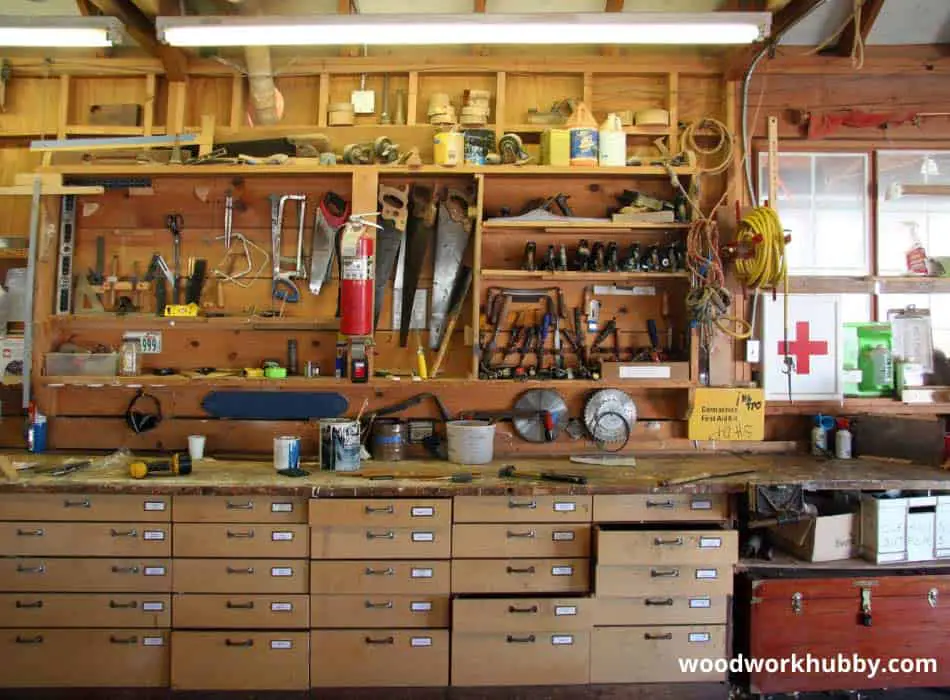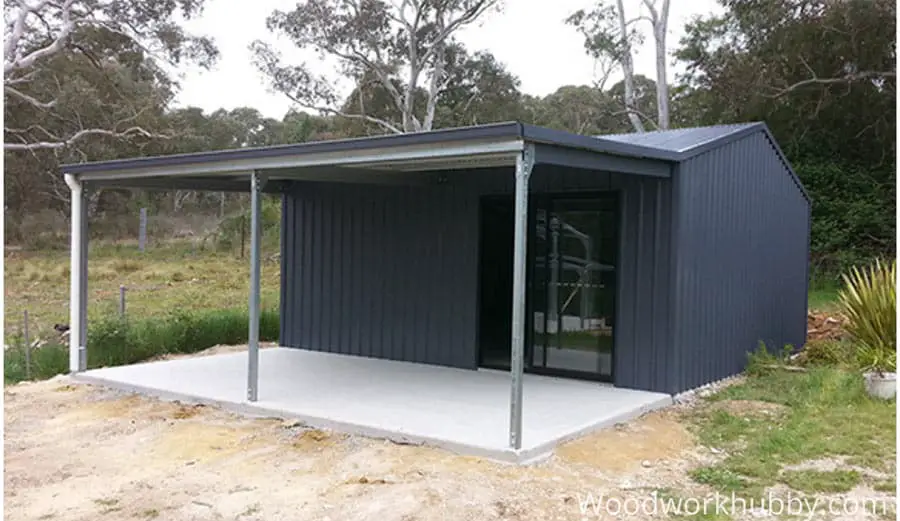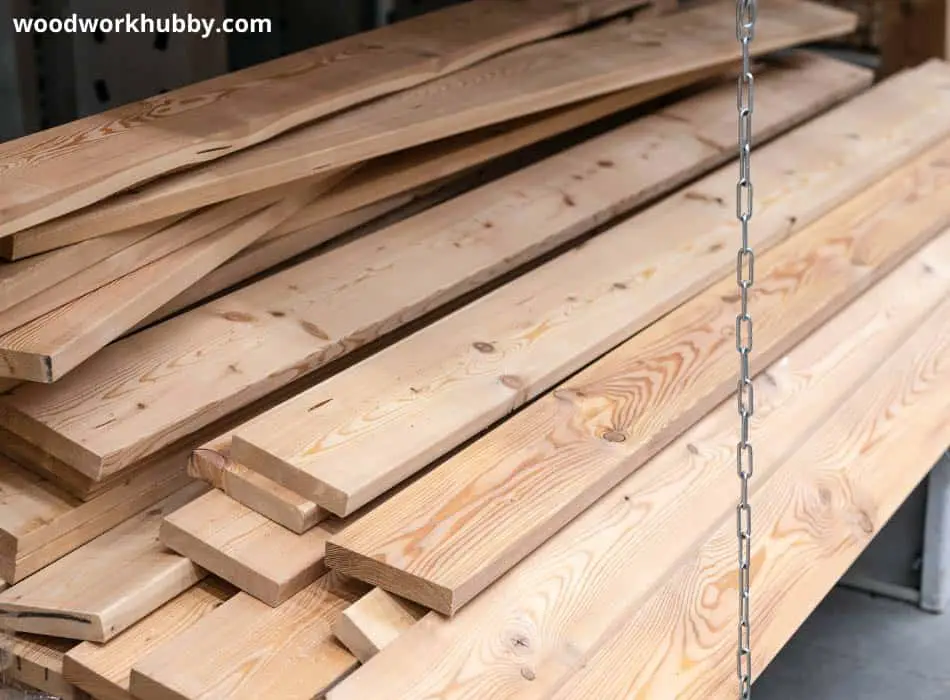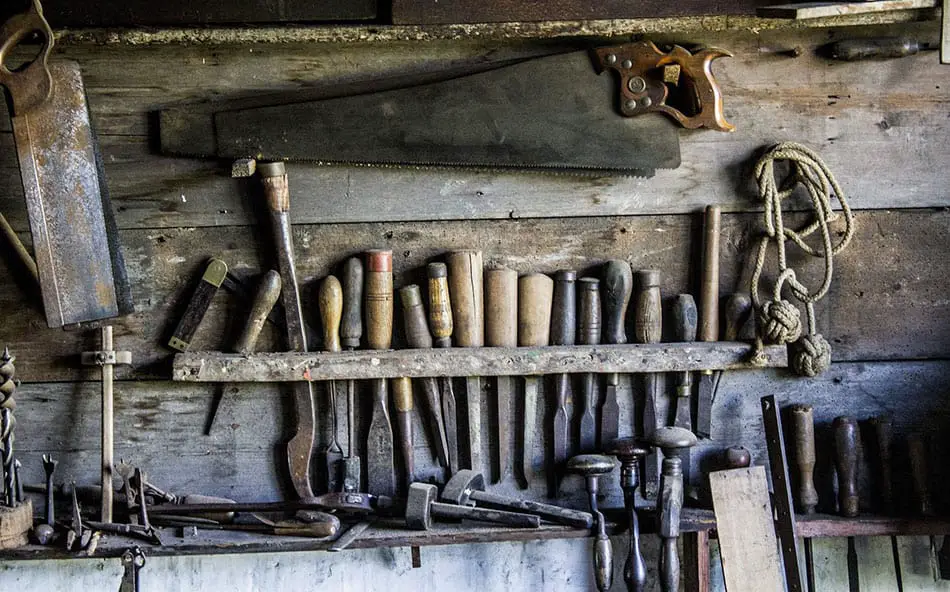The time has come. You have watched all the youtube videos and you just love woodwork and you want to get started with woodwork as a hobby rather than a business. I know you are worried about the cost as those were my exact thoughts. What is the cost of getting started in woodworking?
The cost to get started in Woodwork for the first project is approximately $1,186 to buy some basic tools, equipment, and timber. This accounts for using your own garage as a workshop.
This will be primarily determined by what type of woodworking you intend to do and what kind of tools and workspace you currently have available. You will need to make sure you have all the necessary safety gear, basic tools (e.g., hammer, nails, screwdriver, measuring instrument, etc.), larger devices for cutting and shaping wood, and the wood itself will need to be considered when creating your budget.
The purpose of me writing this article is to make it easier for you to get started with this wonderful hobby. I have made many mistakes when setting up my shop so hopefully, I can guide you on the right path so you don’t also make those same mistakes that I did.
This article will go over all of the information you will need to know about pricing and sourcing your tools, gear, and materials for basic entry-level woodworking.
Some of the larger devices can be stored when not in use to make room for you to work, but that means you will need an area available to store tools and materials. Materials also come in various price ranges, so we will go over each of them and the best way to get started cost-effectively.

By the time you are done with this article, you will know exactly how much money you will need to set aside to create the woodworking shop you need for your projects.
What This Cost Guide Will Include
I will not explain what use the different tools have because that is covered in other articles. I will assume that you know what each item is for and which ones you will need for your projects.
You will most likely not be buying very large things like lathes this early in the process, so we are not going to include them in our pricing examples. Instead, I will be focused on the basics to get you started.
The prices I provide will allow you to get a better idea of how much you will need to budget. Below I have compiled the average costs of tools, gear, space, and material based on lower and higher-end brands and quality.
None of them include the price of shipping, installation, or extra warranties.
Be sure to check out my other article explaining Is Woodworking Expensive?
Beginner Woodworking Tools You Need
All of the prices are taken from online retailers and are for new devices. If you do some shopping around, you may be able to find them for marked down prices or for less secondhand.
However, I wanted to give an accurate view of what prices to expect if you wanted to purchase everything new or in like-new condition.
Be sure to read this if you want to know how to get second-hand tools at the cheapest prices!
Basic Tools Every Woodworker Requires To Start A Shop
Things that you will need to have on hand for most beginner woodworking projects include the following basic items. Most of them can be purchased at a local retailer or using online sites like Amazon.
Tape Measure and Square
You will need these to measure & mark out accurate pieces of your material to ensure your projects go together easily. The cost can vary significantly based on the features, price, and brand.
- Retractable tape measure costs on average between $10 and $40
- A quality square costs between $35 and $100
You can get them for an average total cost of between $25 and $60.
Take a look at the Tape measures and Squares I recommend.
Power Saws and Hand Saws
There are many types of saws, and they all have benefits and specific uses, so you will only likely need one or two to get started. Most beginners have at least a hand saw, and a circular saw in their workshop.
Keep in mind the below prices are for entry-level tools as more advanced fixed machines can run into thousands of dollars.
- Circular saws are generally between $70 and $200
- Jigsaws cost between $70 and $180 on average
- Compound miter saw average between $150 and $800
- Depending on what features you want, a table saw can have a price tag between $200 and $700 (for benchtop models)
- Band saws come in wide varieties of sizes and prices averaging between $350 and $1,000
- Hand saws are on average between $35 and $150
The total cost for getting one of each saw (which is not required) will be between $875 and $3,030.
If I was starting out again, I would get a Circular saw, Jigsaw, Bandsaw, and Handsaw which are going to be much more affordable at between $525 and $1,150.
Take a look at the Saws I recommend.
Planes, Sanders, and Files
The finishing part of any project is what makes it stand out and come to life. You will need to fine-tune and sand the wood prior to applying any finish. I have found these items to be essential.
- Jack planes can be bought for between $80 and $200
- Block planes are more affordable at between $30 and $80
- Scraper planes and spokeshaves can be found between $15 and $60
- Orbital sanders cost on average between $40 and $150
- Hand files usually come in sets, and they can cost between $20 and $30
You can get your files, sanders, and planes for an average total cost of between $195 and $450.
Hammer and Mallets
These tools are used for putting your finished pieces together. Most people have at least a hammer, so it is likely that you will not have to spend any money on that but a mallet is very handy for knocking on pieces of wood or driving chisels.
- Hammers are between $10 to $50 depending on the size and brand
- Mallets cost around $20 to $70 depending on if they come in a set or not
The overall average cost for the two is $20 to $60.
Take a look at the Mallet I recommend.
Power Drill and Screw Gun
Like with the hammer and mallet, you probably already have these two items or at least a hand drill and screwdriver set, so the likelihood that you will need to spend extra to get it is low. Power options make things go faster than their handheld alternatives, and they more than make up for their cost in time saved.
- Power drills are usually between $70 and $200 depending on how many features and battery packs are included
- Screw guns are around $200 but also vary greatly depending on what features you opt for.
The total average cost is between $130 and $250.
Benches and Sawhorses
For a beginner woodworker, the tools that take up the most space will probably be the sawhorses and woodworking benches that everything is going to be set on. These come in a variety of prices depending on quality.
- Metal and plastic sawhorses are between $60 to $180
- Wooden sawhorses are the cheapest option at between $20 and $50 each
- Woodworking benches are not strictly necessary; you can simply put a flat surface over the sawhorses, but if you want something more sturdy, they start at around $200 and go up from there.
Take a look at this video which shows getting started with a cheap workbench for under $50.
Purchasing Space For Your Shop

When you asked yourself, “What is the cost of getting started in woodworking?” it may have not even occurred to you that your current garage space might not be big enough for projects you want to create.
Depending on the size of the finished pieces and tools you will be buying, you may need to invest in a larger space. When determining how much will fit in your garage or current shed, keep in mind that you will also have to store extra materials.
Did you know some of your woodworking can be done outdoors?
Backyard Shed
There are a huge variety of sizes and models for utility sheds and spaces you can add to your backyard. The average cost for kit-style ones that will be big enough for woodworking is around $1,000 though there are some slightly cheaper. This price does not include any installation costs that might be included.
The cost to build a backyard shed will range between $1,500 to $30,000. In general, they cost $15 – $150 per square foot if you were to hire a contractor.
This can run into large sums of money but if you are serious about getting into woodwork, a large workshop space is paramount. Before you start, make sure you check this to ensure you don’t make any costly mistakes!
Shop Rental Spaces
If you do not have a garage or backyard space (e.g., if you live in an apartment or condo), then you can still buy your tools and rent out local shop space.
The cost to rent out a shed or workshop space ranges between $10 and $25 per square foot based on its location. For example, a 30 x 20 foot shed is 600 square feet and will cost between $6,000 and $15,000 per year.
These prices are just average but you can see renting out a shed can get expensive for the hobbyist woodworker. Most people would be looking at starting a woodworking business if renting out a workshop or shed.
Price of Safety Gear For Beginners
For anyone brand new to woodworking, it is important to start off safe and using all the necessary measures to keep yourself from being accidentally injured by the tools that you will be using.
What is Necessary?
The following protective gear is the minimum you should be wearing whenever you are using your tools. Your eyes, ears, and fingers are all easy to permanently damage, so you want to avoid that at all costs.
There are hundreds of variations of each, so you will have the chance to choose the fit and brand that is right for you and your budget.
- Eyewear (e.g., glasses, goggles, etc.)
- Gloves
- Finger guards (e.g., thumb and forefinger leather grips)
- Ear protection (e.g., earplugs, earmuffs, etc.)
- Mask to keep out dust and debris (e.g., dust mask, respirator mask)
- Face shield
New Vs. Used Protective Gear
You can get this gear at any hardware store or retailer with a home improvement section. You can also find them online.
For most safety gear, it is best to purchase them new rather than using secondhand, although like-new items or never-used secondhand gear can sometimes be found at reduced prices on auction sites or your local home improvement store.
Glasses, goggles, and face shields
Eye protection is vital when working with wood because there will be wood chips and sawdust everywhere, which poses a significant safety risk. Even if you are not actively cutting or sanding, you should always wear something over your eyes to protect them.
Goggles or glasses paired with a face shield are best when working with tools that have the potential of spitting back large pieces of debris.
- Safety glasses are between $5 and $10, and they often are sold in sets
- Safety goggles are between $15 and $30
- Face shields that will be able to protect you against flying debris are around $25
The average cost for all three is between $45 and $65.
Finger guards and gloves
Most of the tools you will be using can either cut through or smash your fingers, so it is essential that you protect them. You can also often get splinters from rough sawn wood so I would highly recommend a pair of gloves.
- Cut-resistant gloves are around $11 on average
- Abrasion-resistant, gripping gloves are around $15 to $20
- Finger guards that are leather or cut-resistant are around $10 to $15 for more than one finger
The total cost of hand protection equipment is between $25 and $30.
Earplugs and Earmuffs
Hearing loss is a real safety issue for anyone regularly working with power tools. For exceptionally loud devices, you will want to use both earplugs and earmuffs.
- Earplugs usually come in packs that cost around $11
- Earmuffs are on average $15 to $30
You should have both of these on hand and never use any power tools without wearing at least one of them. My 30 years of doing woodwork have taught me that lesson! I have very slight industrial deafness now from all the years of not wearing ear protection.
The total average for hearing protection is between $26 and $41.
Respirator or Mask
Sawdust is very dangerous for your lungs and can potentially cause an infection. You want to avoid that at all costs. Also, most finishing products like varnishes and paints are full of harmful chemicals. You should use a mask whenever you work in your shop and a respirator when working with harsh chemicals.
- Respirators cost between $30 and $150 depending on quality and size
- Masks with filters are around $11 to $15
The total for both is between $40 and $120.
Extra Gear You Should Consider
While the following items are not necessary to get started, you may look into buying them once you get more established with your hobby. They can cut down on risk and make your projects easier.
- Woodworking apron ($35)
- Utility belt ($25 to $30)
- Headlamp ($15)
Material Prices For Woodworking
The price is going to be determined by where you are located geographically, what kind of materials are available locally, and what type of projects you are working on. You can buy them wholesale or from retailers like Lowe’s, Home Depot, and local woodworking stores.
What Woods to Use For Projects

There are many choices when it comes to which type of wood to use for your project. Some instructions include what wood to use while others do not.
You will want to familiarize yourself with them before you look into buying so that you only buy what you need. There is no need to spend a lot of money on expensive wood for your first projects while you are still learning. Below is a list of wood that is commonly used for woodworking.
- Pine
- Oak
- Walnut
- Rosewood
- Ash
- Hard Maple
- Mahogany
- Teak
- Cedar
- Redwood
- Cherry
Wholesale Vs. Buying Retail
When buying wholesale, you will be getting rough sawn boards, so you will need to mill them straight. This will require extra machines like surface planers and thicknessers to dress the timber which will cost between $2,000 to $5,000 per machine.
While buying wholesale will save you money in the long run, these costs are usually unnecessary for the beginner woodworker. If you are a beginner and just want to build a few projects, then I highly suggest buying retail which means your timber will be pre-dressed.
Pricing For Wood
These price examples are by the piece and taken from www.rockler.com, an online supplier of woodworking resources.
Oak: 3/4″ X 3″ X 24″ $11.99
Walnut: 3/4″ X 3″ X 24″ $12.99
Rosewood: 1/4″ x 1-1/2″ x 24″ $9.99
Ash: 3/4″ X 3″ X 24″ $5.99
Maple: 3/4″ X 3″ X 24″ $9.99
Mahogany: 3/4″ X 3″ X 24″ $6.99
Cherry: 3/4″ X 3″ X 24″ $10.49
I cannot give a total price on materials since it will vary based on the size of your project and which wood you choose. However, you can use these as a guideline when determining how much you are likely to spend.
Other Materials
To build your projects you are going to need consumable items like glue, screws, and nails.
- You can get a kit of 1500 multi-sized nails for $20
- You can get an 800 piece kit of assorted screws for $20
- Wood glues vary but I recommend Titebond for $15
You should get all of these as you never know what you will need and you will always use them. The total cost of glue, screws & nails is $55.
Total Average Cost of Outfitting Your First Woodworking Shop
When creating to get started, there is no need to immediately buy all of the most expensive versions of the various tools. Although I did provide average prices for the high and low end of the pricing spectrum for each of the items listed, I will be using only the smaller amount to total out the amount.
This handy table shows the total minimum costs.
| Item | Minimum Cost |
| Tools | $895 |
| Safety Gear | $136 |
| Consumable Materials | $55 |
| Timber | Varies – average of $100 |
| Total Cost To Get Started | $1,186 |
Workshop Space (not required)
This is an entirely optional step and will not be included in the “total cost” below. However, if you find yourself in need of extra space, then the average cost is $1,000, so you can add that to the total.
Total Cost For All Necessary Items
What is the cost of getting started in woodworking? As you can see from the table above, you can expect to spend approximately $1,186 (not including optional shed) before the extra shipping and optional warranty fees.
Having a budget of $1,000 to $1,500 should make sure you are able to get everything that you need and have a little set aside for unexpected costs (e.g., fuel, installation, etc.). You have everything you need to get started creating your ideal woodworking shop.




